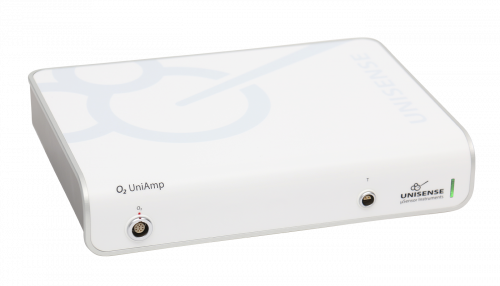



Redox Microelectrode
With the tip size down to 10 µm, less than 5 seconds in response time, and 1 mV in resolution, you will get reliable and fast measurements of redox potential. Read more...
Redox measurement technology
The Redox microelectrode tip will develop an electrical potential relative to the reference electrode when both electrodes are immersed in the same solution and connected to a high-impedance millivoltmeter, such as the UniAmp. This potential reflects the tendency of the solution to release or take up electrons; also called the Oxidation-Reduction Potential (ORP).
The Unisense Redox microelectrode can be used for measurements in salinities from 0 to full ocean strength.
The reference electrode can be either external (separate electrode) or internal. However, we only recommend internal references in applications where it is not possible to place two electrodes in the sample.

| Feature | Standard | Options | Extra price for option selection |
|---|---|---|---|
|
Feature
Total length
|
Standard
150-200 mm
|
Options
120-350 mm
|
Extra price for option selection
20-50%
|
|
Feature
Diameter 20 mm from tip
|
Standard
<2 mm
|
Options
<1 mm
|
Extra price for option selection
10%
|
|
Feature
Diameter 50 mm from tip
|
Standard
8 mm
|
Options
<2 mm
|
Extra price for option selection
20%
|
|
Feature
Glass shaft diameter
|
Standard
8 mm
|
||
|
Feature
Plastic shaft protection diameter*
|
Standard
11 mm
|
Options
Can be omitted
|
Extra price for option selection
|
*When mounted with in situ mini connectors, the shaft has no protection mounted, but fits directly into the in situ sensor mounts with pressure compensation. In situ sensors have a standard length of 130-160 mm.
| Item | Standard | Options | Extra price for option selection |
|---|---|---|---|
|
Item
Cable
|
Standard
Habia
|
||
|
Item
Cable length
|
Standard
1.5-2 m
|
Options
0-5 m
|
Extra price for option selection
Yes, depends on length
|
|
Item
Connector
|
Standard
LEMO
|
Options
BNC adapter
|
Extra price for option selection
Yes, order separately
|
|
Item
In situ mini connectors*
|
Standard
No
|
Options
Yes
|
*When mounted with in situ mini connectors, the shaft has no protection mounted, but fits directly into the in situ sensor mounts with pressure compensation. In situ sensors have a standard length of 130-160 mm.
| Attribute | Standard | Options | Extra price for option selection |
|---|---|---|---|
|
Attribute
Guaranteed lifetime
|
Standard
3 months
|
||
|
Attribute
Expected lifetime
|
Standard
>1 year
|
||
|
Attribute
Temperature range
|
Standard
-10-60°C
|
||
|
Attribute
Temperature range tip
|
Standard
-10-60°C
|
||
|
Attribute
Detection limit
|
Standard
0.1 mV
|
||
|
Attribute
Internal reference
|
Standard
Only as RD-500C*
|
||
|
Attribute
Waterproof
|
Standard
Yes
|
||
|
Attribute
Pressure tolerant tip
|
Standard
Yes
|
||
|
Attribute
Spatial resolution
|
Standard
Equals outside tip diameter
|
||
|
Attribute
Electrolyte with fluorescein (fluorescent)
|
Standard
No
|
Options
Yes
|
Extra price for option selection
10%
|
*Construction of the sensor with an internal reference involves creation of a liquid junction 1-2 mm from the electrode tip. During measurements this liquid junction must be submersed in the medium in order to complete the measurement circuit.
|
Response time (90%)
|
<10 s
|
| Redox Glass Electrode | Size and description | Options | Extra price for option selection |
|---|---|---|---|
|
Redox Glass Electrode
RD-10
|
Size and description
8-12 µm - microelectrode
|
Options
3-5 µm
|
Extra price for option selection
20%
|
|
Redox Glass Electrode
RD-25
|
Size and description
20-30 µm - microelectrode
|
||
|
Redox Glass Electrode
RD-50
|
Size and description
40-60 µm - microelectrode
|
||
|
Redox Glass Electrode
RD-100
|
Size and description
90-110 µm - microelectrode
|
||
|
Redox Glass Electrode
RD-200
|
Size and description
175-225 µm - microelectrode
|
||
|
Redox Glass Electrode
RD-500
|
Size and description
400-600 µm - minielectrode
|
Options
110-400 µm
|
Extra price for option selection
20%
|
|
Redox Glass Electrode
RD-500C
|
Size and description
400-600 µm (combination electrode with internal reference electrode)
|
||
|
Redox Glass Electrode
RD-MR
|
Size and description
400-600 µm - in guide
|
||
|
Redox Glass Electrode
RD-N
|
Size and description
1.1 x 40 mm - needle electrode
|
||
|
Redox Glass Electrode
RD-NP
|
Size and description
1.6 x 40 mm - needle electrode for piercing
|
||
|
Redox Glass Electrode
RD-ST-1/4
|
Size and description
1/4'' steel tube
|
||
|
Redox Glass Electrode
RD-SL-1/4
|
Size and description
FT-cell 1/4'' Swagelok Tee
|
||
|
Redox Glass Electrode
RD-SL-1/8
|
Size and description
FT-cell 1/8'' Swagelok Tee
|
||
|
Redox Glass Electrode
RD-PEEK-1/8
|
Size and description
FT-cell 1/8'' PEEK Tee
|
||
|
Redox Glass Electrode
RD-PEEK-1/16
|
Size and description
FT-cell 1/16'' PEEK Tee
|
||
|
Redox Glass Electrode
RD-FT-GLASS-6
|
Size and description
Glass FT-cell 6 mm outer diameter
|
||
|
Redox Glass Electrode
RD-FT-GLASS-8
|
Size and description
Glass FT-cell 8 mm outer diameter
|
Video Guides

A short presentation of how we make Redox microelectrodes, how you can use them, and a look at specifications and customizations.

Application Scientist Tage Dalsgaard shows you how to perform a calibration using the Redox electrode calibration kit
Quick Enquiry
Related products

UniAmp Multi Channel for all Unisense sensors and electrodes including optical sensors

Economic amplifier portfolio for single analytes - O2, pH/mV, H2, N2O or H2S

Reference electrode for pH or Redox microelectrodes

10 ready-to-use vials for simple one-point calibration of Redox microelectrodes

